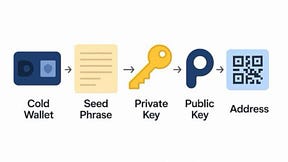I Had Funds Stuck in the FTX Collapse. Here’s How I Store Crypto Now (And Why You Need Multiple Wallets)
November 2022. FTX collapsed.
I had funds stuck on the exchange. Not my entire portfolio – I’d already moved most to cold storage – but enough to hurt.
Three years later, I’m still waiting for partial repayment based on 2022 prices. Meanwhile, the crypto I could have held is worth 7x more.
That’s when I learned: “not your keys, not your coins” isn’t a slogan. It’s a survival rule.
Here’s how I store crypto now – and why you need multiple wallets, not just one.
The Thing Nobody Wants to Talk About
Fast forward to October 2025: Trump pardons CZ. A $4.3 billion Binance fine disappears. Everyone celebrates the regulatory reset.
Me? I’m reminded that if political connections can erase a multi-billion dollar penalty, what makes you think your funds are safe on any exchange?
Binance paid the fine. CZ served four months. Now he’s free, and the exchange is stronger than ever.
Great for crypto adoption. Terrible for anyone who thinks “too big to fail” means “safe to trust.”
Because here’s the reality: exchanges get hacked. They go bankrupt. They freeze withdrawals. And when it happens, your “Bitcoin” is just a number in someone else’s database.
Not your keys, not your coins.
What Exchanges Don’t Tell You
Let me hit you with some numbers that should scare you:
$1.4 billion stolen from exchanges and protocols in 2024. While this is down from 2023, it’s still massive.
Mt.Gox (2014): $450 million gone. Users waited 11 years for compensation – and finally started receiving partial repayment in 2024.
FTX (2022): $8 billion vanished. Sam Bankman-Fried got 25 years. Most users? They got a claims number and are still waiting. The repayment plan promises 118–142% of claim value – but based on 2022 prices. Bitcoin was $16,600 then. Today? $115,000. That’s a 7x opportunity cost.
Binance (multiple incidents): Despite being the largest exchange, they’ve faced security challenges including the 2022 incident that resulted in $570 million affected (later recovered through freezing).
And those are just the big names you’ve heard of. Smaller exchanges? They collapse regularly.
Even if an exchange doesn’t get hacked, they can:
• Freeze your account during “maintenance” (usually when you want to withdraw)
• Go bankrupt and tie your funds up in years of legal proceedings
• Get regulated out of existence in certain jurisdictions
• Decide you violated some Terms of Service you never read
The pattern? You don’t control the keys. They do. And when things go wrong, you’re just another creditor hoping to get pennies back.
What FTX Taught Me
I kept crypto on FTX because it was “convenient.” The interface was clean. The yields were good. Everyone I knew used it. Sam Bankman-Fried was on TV with celebrities. It felt safe.
Then one morning in November 2022, withdrawals stopped. Within 48 hours, FTX filed for bankruptcy.
My funds were locked. No access. No warning.
The FTX bankruptcy process revealed that customer funds had been used for risky trading at Alameda Research. The crypto wasn’t sitting in wallets. It was gone, gambled away.
The worst part? It was completely preventable. If I’d spent a few hundred dollars on hardware wallets and followed proper security, those funds would still be mine – and worth 7x more today.
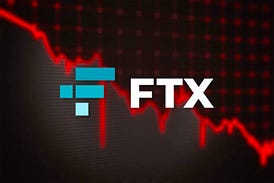
What Actually Keeps Your Crypto Safe
A hardware wallet (also called a cold wallet) is a physical device that stores your private keys offline.
Think of it like this:
• Hot wallet (exchange, phone app): Your keys are online, connected to the internet, vulnerable 24/7.
• Hardware wallet: Your keys never touch the internet. Hackers can’t access what isn’t online.
When you want to send crypto, the transaction gets signed on the device itself, then broadcast. Your private keys never leave the hardware.
Even if your computer is infected with malware, even if you’re using public WiFi, even if someone’s watching your screen – they can’t steal your keys.
It’s not foolproof. Nothing is. But it’s the closest thing to “unhackable” that exists in crypto.
How I Store Crypto Now (The Multi-Layer Strategy)
After FTX, I redesigned my entire approach. Here’s the system I use:
Layer 1: Long-Term Cold Storage
What I use: Multiple hardware wallets from different manufacturers
Why multiple devices:
• Primary Ledger Nano X: Main Bitcoin and Ethereum holdings
• Primary Trezor Model T: Backup + different security architecture
• If one company has a vulnerability, the other protects my holdings
Storage:
• Devices in separate secure locations
• Recovery phrases stored separately from devices
• Never all in one place
What goes here:
• Bitcoin and Ethereum long-term holdings
• Any crypto I won’t touch for years
• The majority of my portfolio
Why this works:
• Offline = unhackable by remote attacks
• Diversified across manufacturers
• Physical separation prevents single point of failure
Layer 2: Active Cold Storage
What I use: Secondary hardware wallet
Why separate from long-term storage:
• I don’t want to constantly access my main cold wallets (security risk)
• This wallet is for crypto I might move in 3–12 months
• Used for staking through official wallet apps
What goes here:
• Crypto I’m staking (earning 3–17% APY)
• Positions I might trade within the year
• Medium-term holdings
Why this works:
• Can stake directly from hardware wallet (through Ledger Live/Trezor Suite)
• Balance between security and accessibility
• Staking rewards without exchange risk
Layer 3: Exchange Holdings
What I use: Two exchanges (Binance + Coinbase)
Wait, didn’t you just say exchanges are risky?
Yes. But here’s the reality: you need exchanges for certain things.
What I keep on exchanges:
• Trading capital
• Stablecoins earning yield (currently 4–8% APY)
• Small amounts of altcoins not supported by hardware wallets
My exchange rules:
• Keep minimal amounts
• Split between two exchanges (diversification)
• Withdraw immediately after buying
• Enable all security features
Why this approach:
• I can buy crypto when opportunities arise
• Earn staking rewards on stablecoins
• If one exchange collapses, I don’t lose everything
The Hardware Wallets I Actually Trust
I’ve tested every major hardware wallet. Some are clunky. Some have terrible interfaces. Here are the ones I’d recommend.
Quick Comparison
💰 Price
• Ledger Nano X: $149
• Trezor Model T: $169
• Tangem Wallet: $50
• Ledger Nano S Plus: $79
🪙 Coins Supported
• Ledger Nano X: 5,500+
• Trezor Model T: 1,500+
• Tangem Wallet: 6,000+
• Ledger Nano S Plus: 5,500+
📱 Connectivity
• Ledger Nano X: Bluetooth + USB ✅
• Trezor Model T: USB only
• Tangem Wallet: NFC (tap to phone) ✅
• Ledger Nano S Plus: USB only
🔐 Form Factor
• Ledger: USB device with screen
• Trezor: USB device with touchscreen
• Tangem: Card (like credit card)
• Ledger: USB device with screen
⭐ My Rating
• Ledger Nano X: 9/10 (best overall)
• Trezor Model T: 9/10 (best for cold storage)
• Tangem Wallet: 7.5/10 (best for beginners)
• Ledger Nano S Plus: 8/10 (best value)
Ledger Nano X – Best Overall ($149)
This is what I use for staking and positions I might move within a year.
What I like:
• Supports 5,500+ cryptocurrencies (basically everything)
• Bluetooth connectivity (you can use it with your phone)
• Ledger Live app is intuitive
• Built-in battery lasts weeks
• Can stake ETH, ADA, SOL, DOT directly from the device
What I don’t like:
• Not fully open-source (Ledger’s security chip is proprietary)
• Slightly pricier than budget options
Who it’s for: Anyone who wants to stake crypto, use DeFi occasionally, or needs mobile access.
Get it here: [Ledger Official Store]
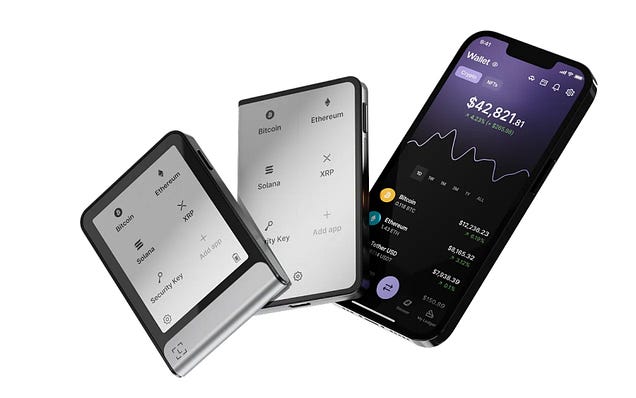
2. Trezor Model T – Best for Cold Storage ($169)
This is what I use for long-term Bitcoin and Ethereum storage.
What I like:
• Fully open-source (hardware and software)
• Color touchscreen interface
• No Bluetooth (some see this as more secure for cold storage)
• Shamir Backup support (can split recovery phrase)
• Strong reputation in Bitcoin community
What I don’t like:
• Supports fewer coins than Ledger (1,500+ vs 5,500+)
• No Bluetooth means less convenient for active use
Who it’s for: Long-term holders who prioritize maximum security and open-source verification.
Get it here: [Trezor Official Store]
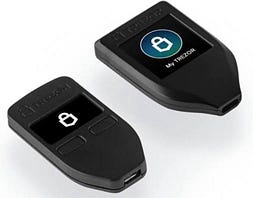
3. Tangem Wallet – Best for Beginners ($50)
A card-based hardware wallet that works with NFC (tap to phone). Easiest to use, but limited functionality.
What I like:
• Cheapest option at $50
• Extremely simple (just tap to phone)
• No charging needed (no battery)
• Supports 6,000+ coins
• Looks like a credit card (discreet)
• Durable (water/dust resistant)
What I don’t like:
• No screen (must trust phone app)
• Can’t stake or use DeFi directly
• Less secure than devices with screens (can’t verify addresses on device)
• Tangem controls some aspects of key generation
Who it’s for: Complete beginners who want the simplest possible setup, or as a backup wallet for small amounts.
Get it here: [Tangem Official Store]
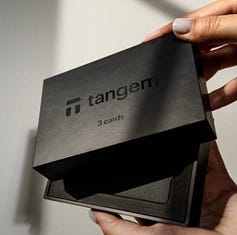
4. Ledger Nano S Plus – Best Budget Option ($79)
Same security as the Nano X, fewer features. Perfect for intermediate users on a budget.
What I like:
• Half the price of Nano X
• Same security chip
• Supports 5,500+ coins
• No battery to worry about
• Larger screen than original Nano S
What I don’t like:
• No Bluetooth (must plug into computer)
• Smaller screen than Nano X
Who it’s for: Intermediate users who don’t need mobile connectivity.
Get it here: [Ledger Official Store]
Which Wallet Should You Actually Get?
If you’re brand new to crypto (less than $500):
Start with Tangem Wallet ($50). It’s simple, cheap, and gets you familiar with self-custody.
If you hold $500-$5,000:
Get Ledger Nano S Plus ($79). Best value, full functionality.
If you hold $5,000-$50,000:
Get Ledger Nano X ($149). You need Bluetooth convenience and staking capability.
If you hold $50,000+:
Get both Ledger Nano X and Trezor Model T ($318 total). Split your holdings across different manufacturers for maximum security.
If you want maximum security for long-term storage:
Get Trezor Model T ($169). Fully open-source, no Bluetooth, perfect for cold storage.
Why I Own Multiple Devices of the Same Model
Here’s something most guides won’t tell you: I don’t just own different wallet brands – I own multiple units of the same model.
My actual setup:
• Two Ledger Nano X devices
• Two Trezor Model T devices
• One Ledger Nano S Plus
• One Tangem (for small amounts/travel)
Total: 6 physical devices.
Why Buy Duplicates?
Hardware Failure
Hardware wallets can break. Screens die. Buttons fail.
When my primary Ledger’s screen started glitching, I simply restored my accounts using the same 24-word phrase on my backup device and continued without missing a beat.
Geographic Redundancy
I keep devices in different locations:
• Primary devices: Secure locations I access regularly
• Backup devices: Separate locations (different city/family member’s house)
If my house burns down, I lose one device. Not all of them.
Firmware Updates
Firmware updates occasionally cause issues.
My rule: Never update all devices at once.
• Update primary device first
• Test for a week
• If stable, update backup
This way, if an update causes problems, I always have a working device.
The Cost-Benefit
Additional cost:
• Extra Ledger Nano X: $149
• Extra Trezor Model T: $169
• Total: $318 for peace of mind
For anyone holding significant crypto, spending an extra $318 on backup devices is obvious risk management.
The Principle of Functional Isolation
Here’s a security concept most people miss: Don’t use the same wallet for everything.
My rule: Storage wallets stay offline. Active wallets handle transactions.
Why This Matters
Imagine you’re interacting with a DeFi protocol. You think you’re approving a legitimate transaction, but it’s actually a phishing attack.
If all your wallets are connected to DeFi:
• Sign malicious transaction on Wallet A → drained
• Check Wallet B → sign similar transaction → drained
• Wallet C? Same pattern → drained
If you practice functional isolation:
• Storage Wallet: Never connects to DeFi, never signs smart contracts
• Staking Wallet: Only used through official apps (Ledger Live, Trezor Suite)
• Active Wallet: Used for DeFi, swaps, experiments
Result: Even if your Active Wallet gets drained, your Storage Wallet was never exposed.
My Actual Wallet Functions
Cold Storage Wallets (Never Touch These):
• Primary devices: Bitcoin and Ethereum long-term holdings ONLY
• No DeFi interactions
• No smart contract approvals
• Only receives deposits
• Stored in secure locations, rarely accessed
Staking Wallet:
• Secondary device: Staking ONLY through official apps
• Ethereum, Cardano, Polkadot staking
• No external DeFi protocols
• No token approvals outside official apps
Active Wallet:
• Tertiary device: DeFi, swaps, new protocols
• This wallet interacts with smart contracts
• Holds smaller amounts
• If compromised, limited loss
Travel/Daily Wallet:
• Tangem card: Small amounts for daily transactions
• Easy to carry, tap to phone
• If lost or stolen, minimal loss
Use Different Recovery Phrases
This is critical:
• Storage Wallet = Recovery Phrase A
• Staking Wallet = Recovery Phrase B
• Active Wallet = Recovery Phrase C
• Travel Wallet = Recovery Phrase D
If your Active Wallet’s seed phrase gets compromised, your Storage Wallet remains safe.
The Setup Process
For Ledger:
1. Unbox, plug in via USB
2. Set up 8-digit PIN
3. Write down 24-word recovery phrase (CRITICAL)
4. Install Ledger Live app
5. Add Bitcoin/Ethereum accounts
6. Transfer small test amount ($20)
7. Confirm it arrives, then transfer the rest
Total time: 20–30 minutes
For Trezor:
1. Plug in, follow touchscreen prompts
2. Set up PIN
3. Write down 24-word recovery phrase
4. Install Trezor Suite
5. Add accounts
6. Test transfer, then move main holdings
Total time: 20–30 minutes
For Tangem:
1. Download Tangem app on phone
2. Tap card to phone (NFC)
3. Create wallet (Tangem generates keys on card)
4. Write down backup card access code
5. Transfer small test amount
6. Verify it arrives
Total time: 10–15 minutes (easiest setup)
The One Mistake That Will Cost You Everything
Losing or exposing your 24-word recovery phrase.
That phrase IS your crypto. If someone gets it, they own your funds. If you lose it and your device breaks, your crypto is gone forever.
What NOT to do:
• ❌ Don’t take a photo
• ❌ Don’t store it digitally
• ❌ Don’t store it with your hardware wallet
• ❌ Don’t tell anyone, ever
What TO do:
• ✅ Write it on the card provided
• ✅ Store in a fireproof safe
• ✅ Consider a metal backup (survives fire/flood)
• ✅ Store backup copy in different physical location
• ✅ Never store all backups together
What I Learned From FTX
Lesson 1: Centralization is a single point of failure
FTX wasn’t hacked. It was mismanaged. Your funds are only as safe as the people running the platform.
Lesson 2: “Too big to fail” doesn’t exist in crypto
FTX was the second-largest exchange. It collapsed in 48 hours.
Lesson 3: Diversification isn’t optional
If I’d split my holdings properly across cold wallets and multiple exchanges, my losses would have been minimal.
Lesson 4: Liquidity matters
Having some funds accessible means you can act when opportunities arise. Complete cold storage sounds safe, but it’s inflexible.
Lesson 5: Self-custody is the endgame
The goal isn’t to avoid exchanges forever. It’s to minimize exposure and maximize self-custody for holdings you don’t need to touch.
My Recommendations Based on Your Holdings
If you hold less than $500:
Start with Tangem Wallet ($50). Simple, cheap, gets you started with self-custody.
If you hold $500-$5,000:
Get Ledger Nano S Plus ($79). Best value with full functionality.
If you hold $5,000-$50,000:
Get Ledger Nano X ($149) + backup device. You need mobile access and redundancy.
If you hold $50,000-$500,000:
Get Ledger Nano X + Trezor Model T ($318). Split across manufacturers. Add backups of each.
If you hold $500,000+:
Get multiple devices, use functional isolation, consider multi-sig, consult a security expert.
The Real Cost of Not Acting
A Ledger Nano X costs $149.
FTX taught thousands of people this lesson the hard way. Average losses? Thousands per person.
So you’re risking thousands to save $149.
That’s not being frugal. That’s gambling with money you can’t afford to lose.
Here’s What You Should Do Right Now
If you’re holding crypto on an exchange, you’re taking an unnecessary risk.
For most people: Get a Ledger Nano X ($149)
On a tight budget: Get a Tangem Wallet ($50) or Ledger Nano S Plus ($79)
For serious holdings: Get both Ledger Nano X and Trezor Model T ($318 total)
Set it up this weekend. Transfer your funds. Sleep better.
Not your keys, not your coins. Don’t learn this the hard way.
Transparency Note
Some links in this article are affiliate links. If you buy through them, I earn a small commission at no extra cost to you. I only recommend products I’ve personally tested and use myself. The hardware wallets protecting my crypto right now were purchased with my own money, and I sleep better because of them.
What’s your setup? Still keeping funds on exchanges, or have you made the move to cold storage? Drop a comment below – I read every one.
I Had Funds Stuck in the FTX Collapse. was originally published in The Capital on Medium, where people are continuing the conversation by highlighting and responding to this story.
